
VNU Journal of Science: Natural Sciences and Technology, Vol. 39, No. 3 (2023) 33-40
33
Original Article
Analysis and Pollution Assessment
of Brominated Flame Retardants (PBDEs, DBDPE, and BTPBE)
in Settled Dust from E-waste and Vehicle Processing Areas
in Northern Vietnam
Hoang Quoc Anh1,*, Trinh Hai Minh1, Pham Dang Minh1, Tu Minh Nhat2,
Nguyen Le Hong Minh1, Tu Binh Minh1, Shin Takahashi3
1VNU University of Science, 19 Le Thanh Tong, Hoan Kiem, Hanoi, Vietnam
2University of Science and Technology of Hanoi (USTH), 18 Hoang Quoc Viet, Cau Giay, Hanoi, Vietnam
3Ehime University, 3-5-7 Tarumi, Matsuyama, Ehime, Japan
Received 28 December 2022
Revised 22 March 2023; Accepted 12 March 2023
Abstract: Polybrominated diphenyl ethers (PBDEs), decabromodiphenyl ethane (DBDPE), and
1,2-bis(2,4,6-tribromophenoxy)ethane (BTBPE) are typical brominated flame retardants (BFRs),
which were widely added to polymeric and textile materials to meet fire safety requirements.
PBDEs (including commercial penta-, octa-, and deca-BDE mixtures) have been classified as
persistent organic pollutants (POPs) under the Stockholm Convention, while DBDPE and BTBPE
are PBDE replacements. In the present study, concentrations of PBDEs (major congeners of
technical PBDE mixtures such as BDE-28, 47, 99, 100, 153, 154, 183, 197, 207, and 209), DBDPE
and BTBPE were simultaneously analyzed in settled dust samples collected from e-waste and
end-of-life vehicle (ELV) processing areas in Northern Vietnam. The dust samples were extracted
using an ultrasonic processor and subsequently by acetone and acetone/hexane (1:1) mixture for
10 min each time. The dust extract was treated with concentrated sulfuric acid and activated silica
gel to remove interferences. BFRs were analyzed by using gas chromatography/mass spectrometry
(GC/MS) equipped with a DB-5ht column. The mass spectrometer was operated at electron
capture negative ionization (ECNI) and selected ion monitoring (SIM) mode. Concentrations of
total PBDEs, DBDPE, and BTBPE ranged from 77 to 240,000 (median 6000), from <20 to 240,000
(median 5500), and from <10 to 9200 (median 160) ng/g, respectively. Concentrations of BFRs in the
e-waste dust were significantly higher than those measured in the ELV dust, suggesting e-waste
processing activities as potential sources of BFRs in the dust. Among the BFRs analyzed,
BDE-209 and DBDPE were the most predominant compounds, implying intensive application of
deca-BDE mixtures and alternative formulations.
Keywords: PBDEs, DBDPE, BTBPE, settled dust, waste processing.*
_______
* Corresponding author.
E-mail address: hoangquocanh1990@gmail.com
https://doi.org/10.25073/2588-1140/vnunst.5525

H. Q. Anh et al. / VNU Journal of Science: Natural Sciences and Technology, Vol. 39, No. 3 (2023) 33-40
34
Phân tích hàm lượng và đánh giá ô nhiễm các chất chống cháy
brom hữu cơ (PBDEs, DBDPE và BTBPE) trong mẫu bụi lắng
tại khu vực xử lý rác thải điện tử và phương tiện giao thông
ở miền Bắc Việt Nam
Hoàng Quốc Anh1,*, Trịnh Hải Minh1, Phạm Đăng Minh1, Từ Minh Nhật2,
Nguyễn Lê Hồng Minh1, Từ Bình Minh1, Shin Takahashi3
1Trường Đại học Khoa học Tự nhiên, Đại học Quốc gia Hà Nội,
19 Lê Thánh Tông, Hoàn Kiếm, Hà Nội, Việt Nam
2Trường Đại học Khoa học và Công nghệ Hà Nội (USTH),
18 Hoàng Quốc Việt, Cầu Giấy, Hà Nội, Việt Nam
3Đại học Ehime, 3-5-7 Tarumi, Matsuyama, Ehime, Nhật Bản
Nhận ngày 28 tháng 12 năm 2022
Chỉnh sửa ngày 02 tháng 3 năm 2023; Chấp nhận đăng ngày 12 tháng 3 năm 2023
Tóm tắt: Polybrom diphenyl ete (PBDEs), decabromdiphenyl etan (DBDPE) và
1,2-bis(2,4,6-tribromophenoxy)etan (BTBPE) là các chất chống cháy brom hữu cơ (BFRs) điển
hình, được sử dụng rộng rãi trong các vật liệu polyme và vật liệu dệt để đảm bảo các yêu cầu về an
toàn phòng cháy. PBDEs (bao gồm các hỗn hợp thương mại penta-, octa- và deca-BDE) được liệt
kê vào nhóm các chất ô nhiễm hữu cơ khó phân hủy (POPs) của Công ước Stockholm, trong khi
đó DBDPE và BTBPE được coi là những chất thay thế cho PBDEs. Trong nghiên cứu này, hàm
lượng của các PBDEs (bao gồm các cấu tử là thành phần chính của hỗn hợp PBDEs thương mại:
BDE-28, 47, 99, 100, 153, 154, 183, 197, 207, 209), DBDPE và BTBPE được phân tích đồng thời
trong mẫu bụi lắng thu thập tại một số khu vực tái chế rác thải điện tử (e-waste) và phương tiện
giao thông hết hạn sử dụng (ELV) ở miền Bắc Việt Nam. Mẫu bụi được chiết bằng phương pháp
chiết siêu âm trực tiếp lần lượt với axeton và hỗn hợp axeton/hexan (1:1), mỗi lần chiết trong
10 phút. Dịch chiết mẫu bụi được xử lý bằng axit sunfuric đặc và silica gel hoạt hóa để loại bỏ các
tạp chất. Các BFRs được phân tích trên hệ thống sắc ký khí khối phổ (GC/MS) với cột tách
DB-5ht. Khối phổ kế được vận hành ở chế độ ion hóa âm bắt giữ điện tử (ECNI) và chế độ quan
sát chọn lọc ion (SIM). Hàm lượng PBDEs, DBDPE và BTBPE dao động từ 77 đến 240000
(trung vị 6000), từ <20 đến 240000 (trung vị 5500), và từ <10 đến 9200 (trung vị 160) ng/g, tương
ứng. Hàm lượng BFRs trong các mẫu bụi tại khu vực tái chế rác thải điện tử lớn hơn đáng kể so
với mẫu bụi tại khu vực tháo dỡ ELV, cho thấy hoạt động tái chế e-waste là nguồn phát thải đáng
kể BFRs trong bụi. Trong số các BFRs được phân tích, BDE-209 và DBDPE có hàm lượng cao
nhất, phản ánh sự áp dụng rộng rãi của hỗn hợp deca-BDE thương mại và các công thức thay thế.
Từ khóa: PBDEs, DBDPE, BTBPE, bụi lắng, xử lý rác thải.
1. Mở đầu *
Chất chống cháy (flame retardants, FRs) là
các hóa chất được thêm vào vật liệu polyme và
_______
* Tác giả liên hệ.
Địa chỉ email: hoangquocanh1990@gmail.com
https://doi.org/10.25073/2588-1140/vnunst.5525
được sử dụng trong các ngành sản xuất nhựa,
dệt may, điện tử và nhiều ngành công nghiệp
khác do chúng có khả năng ức chế hoặc làm
chậm sự lan rộng của đám cháy [1]. Các FRs
được chia thành 2 nhóm chính: các hợp chất vô
cơ (ví dụ như các oxit của antimon, các
hydroxit của nhôm và magie, các muối borat)
và các hợp chất hữu cơ (ví dụ như photphat

H. Q. Anh et al. / VNU Journal of Science: Natural Sciences and Technology, Vol. 39, No. 3 (2023) 33-40
35
este; các hợp chất chứa clo, brom hoặc đồng
thời clo và brom; các hợp chất chứa nitơ) [2].
Chất chống cháy brom hữu cơ (brominated
flame retardants, BFRs) được sử dụng phổ biến
nhất là polybrom diphenyl ete (PBDEs),
hexabromcyclododecan (HBCD) và
tetrabrombisphenol-A (TBBP-A). Trong giai
đoạn 1970-2005 tổng lượng PBDEs được sản
xuất trên toàn thế giới ước tính lên đến
1,3-1,5 triệu tấn [3]. Việc liệt kê PBDEs trong
danh sách các chất ô nhiễm hữu cơ khó phân
hủy (persistent organic pollutants, POPs) cần
phải loại bỏ theo Công ước Stockholm là tiền
đề cho sự sản xuất và sử dụng của các chất
BFRs thay thế, điển hình là decabromdiphenyl
etan (DBDPE) và 1,2-bis(2,4,6-
tribromphenoxy) etan (BTBPE) [4]. Công thức
cấu tạo của PBDEs, DBDPE và BTBPE được
trình bày trong Hình 1.
Trong nghiên cứu này, hàm lượng của các
chất chống cháy brom hữu cơ cũ và mới, bao
gồm PBDEs, DBDPE và BTBPE được phân
tích đồng thời trong các mẫu bụi thu thập tại
các khu vực tái chế rác thải điện tử và phương
tiện giao thông hết hạn sử dụng ở miền Bắc
Việt Nam. Mẫu bụi được chúng tôi lựa chọn để
nghiên cứu vì những lý do chính sau đây:
i) Mẫu bụi có thể dễ dàng thu thập, bảo quản và
có sẵn ở mọi nơi; ii) Bụi có khả năng hấp phụ
cao và là nguồn tiếp nhận nhiều nhóm chất hữu
cơ khác nhau; và iii) Bụi được đánh giá là
nguồn phơi nhiễm đáng kể các chất hữu cơ,
điển hình là BFRs, ở con người. Mẫu bụi được
chiết bằng kỹ thuật chiết siêu âm trực tiếp. Dịch
chiết mẫu bụi được xử lý bằng axit sunfuric đặc
và cột sắc ký chứa silica gel hoạt hóa để loại bỏ
các tạp chất. Các BFRs được tách và phân tích
trên hệ thống sắc ký khí khối phổ (GC/MS) với
cột tách DB-5ht. Khối phổ kế được vận hành ở
chế độ ion hóa âm bắt giữ điện tử (ECNI) và
chế độ quan sát chọn lọc ion (SIM). Kết quả
phân tích hàm lượng BFRs trong mẫu bụi sẽ
cung cấp những thông tin cập nhật về sự tồn tại
đồng thời của các BFRs đã bị cấm sử dụng
(PBDEs) và các BFRs thay thế, đang được sử
dụng (DBDPE và BTBPE) liên quan đến các
hoạt động tái chế rác thải ở Việt Nam.
Hình 1. Công thức cấu tạo của PBDEs,
DBDPE và BTBPE.
2. Thực nghiệm
2.1. Thiết bị, hóa chất
Mẫu bụi được chiết bằng thiết bị chiết siêu
âm trực tiếp VCX 130 (130 W, 20 kHz, Sonic
và Materials, Inc., USA). PBDEs được phân
tích trên hệ thống sắc ký khí khối phổ tứ cực
GCMS-QP2010 Ultra (Shimadzu, Nhật Bản).
Cột tách mao quản silica DB-5ht với pha tĩnh
tương đương 5% phenyl 95% metyl polysiloxan
(15 m × 0,25 mm × 0,10 μm, Agilent
Technologies, USA) được sử dụng để tách các
chất phân tích.
Dung dịch chuẩn (BDE-28, 47, 99, 100,
153, 154, 183, 197, 207, 209, DBDPE và
BTBPE) và chất chuẩn đánh dấu đồng vị
13C12-BDE-209 được cung cấp bởi Wellington
Laboratories (Canada). Chất chuẩn đánh dấu flo
bao gồm FBDE-99, 168, 183, 208 được cung
cấp bởi AccuStandard (USA). Các chất
chuẩn FBDE-99, FBDE-183, FBDE-208 và
13C12-BDE-209 được sử dụng làm chất đồng
hành của các chất phân tích (được thêm vào
mẫu bụi trước khi chiết và dùng để tính toán

H. Q. Anh et al. / VNU Journal of Science: Natural Sciences and Technology, Vol. 39, No. 3 (2023) 33-40
36
hàm lượng chất phân tích trong mẫu). Chất nội
chuẩn FBDE-168 được thêm vào dung dịch
mẫu trước khi phân tích trên hệ thống GC/MS
để đánh giá độ thu hồi của các chất đồng hành.
Các dung môi và hóa chất tinh khiết phân
tích bao gồm axeton, hexan, diclometan
(DCM), nonan, natri sunfat khan, axit sunfuric
98% và silica gel được cung cấp bởi Wako Pure
Chemical Industries, Ltd. (Nhật Bản). Natri
sunfat được nung ở 400 °C trong ít nhất 2 giờ.
Silica gel được hoạt hóa ở 130 °C trong 3 giờ.
Nước cất được sử dụng là nước cất 2 lần đã
được chiết với hexan để loại bỏ các tạp chất
hữu cơ.
2.2. Thu thập và chuẩn bị mẫu bụi
Các mẫu bụi được thu thập trong các xưởng
tái chế rác thải điện tử tại thôn Bùi, xã Cẩm Xá,
huyện Mỹ Hào, tỉnh Hưng Yên (n = 5, ký hiệu
mẫu EW-1 đến EW-5) và các xưởng tháo dỡ
phương tiện giao thông hết hạn sử dụng tại thôn
Thuyền, xã Dĩnh Trì, thành phố Bắc Giang, tỉnh
Bắc Giang (n = 5, ký hiệu mẫu ELV-1 đến
ELV-5) trong tháng 9/2019. Hình ảnh mô tả
hoạt động tại các xưởng xử lý rác thải được thể
hiện trong Hình 2.
Hình 2. Mô tả hoạt động xử lý rác thải điện tử (a) và
phương tiện giao thông (b) tại khu vực nghiên cứu.
Các mẫu bụi được thu thập bằng phương
pháp quét thủ công trên sàn và bề mặt đồ nội
thất, vật dụng trong xưởng với chổi và xẻng hót
không làm bằng vật liệu nhựa (ví dụ như chổi
rơm, chổi lông thú, bìa cứng) để hạn chế ảnh
hưởng của các phụ gia có trong nhựa. Tại mỗi
xưởng, một mẫu gộp đại diện được thu thập và
chuyển vào phoi nhôm kích thước 30 × 30 cm
(đã được tráng rửa bằng dung môi), gói kín và
giữ trong túi polyetylen có khóa zip. Tại phòng
thí nghiệm, mẫu bụi được rây qua sàng bằng
thép không gỉ có khẩu độ 250 m để loại bỏ các
dị vật có kích thước lớn và đồng nhất và để thu
được lượng bụi cỡ 1 g đủ cho bước phân tích
định lượng. Mẫu bụi sau khi rây được chuyển
vào chai thủy tinh (có nút nhám thủy tinh) và
bảo quản ở nhiệt độ -20 °C đến khi phân tích.
2.3. Quy trình xử lý mẫu
Quy trình phân tích được tham khảo từ
nghiên cứu trước đây của chúng tôi [5]. Khoảng
1 g mẫu được cân trong ống thủy tinh 50 mL và
thêm chuẩn hỗn hợp chất đồng hành (FBDE-99,
183, 208 và 13C12-BDE-209) và để cân bằng
trong 30 phút trước khi chiết. Mẫu được chiết
lần lượt với 10 mL axeton trong 10 phút, và
10 mL hỗn hợp axeton/hexan (1:1) trong 10
phút. Sau mỗi lần chiết, ống chứa mẫu được li
tâm với tốc độ 3000 vòng/phút trong 10 phút để
tách dịch chiết và bã rắn. Các phần dịch chiết
được hút bằng pipet Pasteur và chuyển vào bình
cầu 50 mL. Dịch chiết mẫu được cô quay chân
không và chuyển vào 5 mL hexan trong ống
thủy tinh 10 mL trước khi làm sạch.
Dịch chiết mẫu được trộn với 2 mL axit
sunfuric 98% trên máy lắc xoáy trong 1 phút, li
tâm với tốc độ 3000 vòng/phút trong 10 phút và
hút bỏ lớp axit phía dưới bằng pipet Pasteur.
Quá trình xử lý mẫu với axit sunfuric được lặp
lại thêm 2 lần đến khi lớp axit không còn màu.
Dung dịch mẫu sau đó được trộn với 2 mL
nước cất để loại bỏ lượng axit dư. Quá trình rửa
mẫu với nước cũng được lặp lại thêm 2 lần. Cột
sắc ký thủy tinh (dài 30 cm, đường kính trong
1 cm) được chuẩn bị với các lớp hóa chất lần
lượt (từ dưới lên trên) như sau: bông thủy tinh,
1 g natri sunfat, 3 g silica gel hoạt hóa, 1 g natri
sunfat. Cột được làm sạch bằng 20 mL hexan,

H. Q. Anh et al. / VNU Journal of Science: Natural Sciences and Technology, Vol. 39, No. 3 (2023) 33-40
37
nạp dịch chiết mẫu và rửa giải BFRs bằng
30 mL hỗn hợp dung môi DCM/hexan (1:3).
Dịch rửa giải được thu vào bình cầu 100 mL và
cô quay chân không đến 1 mL. Dịch chiết được
chuyển sang ống cô đặc và cô dưới dòng khí
nitơ, thêm chất nội chuẩn FBDE-168 và chuyển
vào 100 μL nonan. Dung dịch phân tích (1 μL)
được tiêm vào hệ thống GC/MS để tách và định
lượng các BFRs.
2.4. Phân tích định lượng trên GC/MS
Các BFRs được phân tích trên hệ thống
GCMS-QP2010 Ultra (Shimadzu, Nhật Bản)
với detector khối phổ dạng tứ cực. Cột tách mao
quản silica DB-5ht (15 m ×0,25 mm × 0,10 m;
Agilent Technologies) được sử dụng để tách
các BFRs. Khí mang heli có tốc độ dòng
1 mL/phút. Nhiệt độ cổng bơm mẫu, bộ phận
ghép nối GC/MS và nguồn ion lần lượt là 260,
310 và 250 °C. Chương trình nhiệt độ của lò cột
được cài đặt như sau: 135 °C (giữ 1 phút), tăng
đến 215 °C (10 °C/phút), tăng đến 275 °C
(5 °C/phút), tăng đến 295 °C (20 °C/phút, giữ
0,5 phút), tăng đến 310 °C (20 °C/phút, giữ
4 phút). Detector khối phổ được vận hành ở chế
độ ion hóa âm bắt giữ điện tử (ECNI) sử dụng
metan là khí phản ứng. Chế độ quan sát chọn
lọc ion (SIM) được dùng để ghi nhận tín hiệu
đo với các mảnh ion định lượng có m/z =
79,0/81,0 (Br–), 158,8/160,8 (HBr2–),
406,6/408,6 (C6HBr4O–), 486,5/488,5 (C6Br5O–).
Hàm lượng BFRs được tính theo phương pháp
nội chuẩn.
2.5. Đảm bảo và kiểm soát chất lượng (QA/QC)
Mỗi lô mẫu thực tế được phân tích kèm với
một mẫu trắng (được chuẩn bị từ natri sunfat
khan) và một mẫu bụi thêm chuẩn (nền mẫu bụi
đại diện được trộn từ khoảng 20 mẫu bụi thu
thập ở Hà Nội và một số tỉnh miền Bắc năm
2016, sau đó được thêm lượng chất chuẩn BFRs
với lượng tuyệt đối dao động từ 0,8 đến
16 ng/mẫu). Trong số các chất phân tích, có 3
chất được phát hiện trong mẫu trắng bao gồm:
BDE-47 (0,050 ± 0,030), BDE-207 (0,080 ±
0,030) và BDE-209 (0,40 ± 0,10) ng/mẫu. Hàm
lượng của các PBDEs trong mẫu thực tế đã
được hiệu chỉnh bằng cách trừ đi hàm lượng
của chúng phát hiện được trong mẫu trắng. Giới
hạn phát hiện của các chất phân tích dao động
từ 0,2 ng/g (BDE-28 và 100) đến 10 ng/g
(BDE-209 và DBDPE). Độ thu hồi của BFRs
trong mẫu thêm chuẩn dao động từ 70% đến
115%. Độ thu hồi của chất đồng hành trong các
mẫu thực tế dao động từ 60% đến 125%. Độ
lệch chuẩn của BFRs trong các mẫu thêm chuẩn
phân tích lặp lại (n = 3) nhìn chung đều <20%.
2.6. Đánh giá rủi ro
Liều lượng hấp thụ hàng ngày (DID,
ng/kg/ngày) của các BFRs từ bụi được ước tính
cho các công nhân tham gia hoạt động tái chế
e-waste và tháo dỡ ELV theo công thức sau:
DID = C × IR × TF / BW [5-7]. Trong đó C là
hàm lượng BFRs trong bụi (ng/g); IR là tốc độ
hấp thụ bụi (0,05 g/ngày); TF là phần thời gian
làm việc trong ngày (8 giờ/24 giờ); BW là trọng
lượng cơ thể trung bình (60 kg). Liều lượng hấp
thụ hàng ngày được so sánh với các liều lượng
tham chiếu (RfD). Tốc độ hấp thụ bụi
0,05 g/ngày được tham khảo từ Sổ tay hệ số
phơi nhiễm (Exposure Factors Handbook) của
Cục Bảo vệ môi trường Hoa Kỳ (US EPA)
(EPA/600/R-17/384F). Liều lượng tham chiếu của
các chất được đưa ra bởi Hệ thống thông tin rủi ro
tích hợp (Integrated Risk Information System) của
US EPA (https://www.epa.gov/iris).
3. Kết quả và thảo luận
3.1. Hàm lượng BFRs trong mẫu bụi
BFRs được phát hiện trong tất cả các mẫu
bụi tại 2 khu vực nghiên cứu với hàm lượng
tổng dao động từ 77 đến 450000 (trung vị
18000) ng/g. Mức hàm lượng này nhìn chung
cao hơn đáng kể so với giá trị đo được trong các
mẫu bụi trong nhà ở khu vực đô thị tại Hà Nội
(trung vị 440, khoảng 120-2400 ng/g) [6]. Các
kết quả này cho thấy hoạt động tái chế và xử lý
rác thải, đặc biệt là rác thải điện tử, là những
nguồn phát thải đáng lưu ý của BFRs. Hàm
lượng của tổng PBDEs, DBDPE và BTBPE
trong các mẫu bụi tại khu vực tái chế e-waste và
khu vực tháo dỡ phương tiện giao thông được
trình bày trong Hình 3.


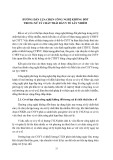
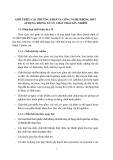
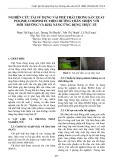
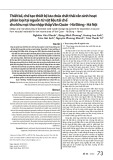
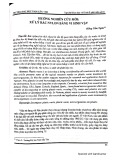
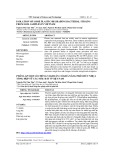
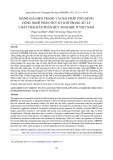
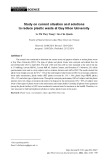
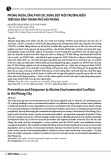

![Tài liệu Vi sinh vật môi trường [Mới nhất]](https://cdn.tailieu.vn/images/document/thumbnail/2025/20251123/ngkimxuyen/135x160/21891763953413.jpg)
![Sổ tay truyền thông Phân loại chất thải rắn sinh hoạt trên địa bàn tỉnh Quảng Nam [Chuẩn nhất]](https://cdn.tailieu.vn/images/document/thumbnail/2025/20251114/kimphuong1001/135x160/1701763094001.jpg)
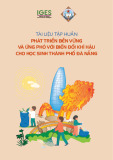

![Quản lý chất thải nguy hại: Sổ tay Môi trường [Chuẩn nhất]](https://cdn.tailieu.vn/images/document/thumbnail/2025/20251029/kimphuong1001/135x160/9011761720170.jpg)









